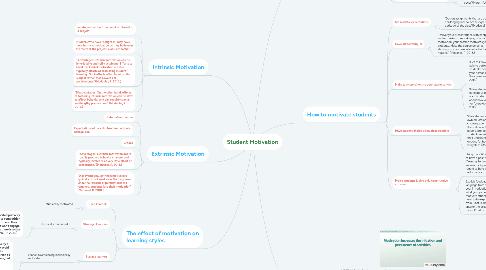
1. Intrinsic Motivation
1.1. Innate motivation from genuine interest in a subject
1.2. Students who have "bought in" may have more intrinsic motivation bc they believe in the merit of the project, class, or teacher
1.3. "Advantages: Intrinsic motivation can be long-lasting and self-sustaining. Efforts to build this kind of motivation are also typically efforts at promoting student learning. Such efforts often focus on the subject rather than rewards or punishments."(Mcdaniel, R. 2018.)
1.4. "Disadvantages: On the other hand, efforts at fostering intrinsic motivation can be slow to affect behavior and can require special and lengthy preparation." (Mcdaniel, R. 2018.)
2. Extrinsic Motivation
2.1. External motivation
2.2. Expectations of parents, teachers, schools, college, etc.
2.3. Grades
2.4. "Advantages: Extrinsic motivators more readily produce behavior changes and typically involve relatively little effort or preparation."(Mcdaniel, R. 2018.)
2.5. "Disadvantages...extrinsic motivators typically do not work over the long term. Once the rewards or punishments are removed, students lose their motivation" (Mcdaniel, R. 2018.)
3. The effect of motivation on learning styles
3.1. Deep Learners
3.1.1. Intrinsically motivated
3.2. Strategic Learners
3.2.1. Extrinsically motivated
3.2.1.1. "Strategic learners are motivated primarily by rewards. They react well to competition and the opportunity to best others. They often make good grades but won’t engage deeply with a subject unless there is a clear reward for doing so."(Mcdaniel, R. 2018.)
3.3. Surface learners
3.3.1. Leans towards being extrinsically motivated
3.3.1.1. "Surface learners are often motivated by a desire to avoid failure. They typically avoid deep learning because it they see it as inherently risky behavior. They will often do what it takes to pass an exam or course, but they won’t choose to go beyond the minimum required for fear of failure."(Mcdaniel, R. 2018.)
4. The importance of student motivation
4.1. "Motivation directs behavior toward particular goals"(Hurst, M).
4.2. "Motivation also leads to increased effort and energy. Motivation determines whether a student will pursue a task (even a difficult one) with enthusiasm or a lackluster attitude" (Hurst, M).
4.3. Motivation and effort go hand in hand. Without moivation, our students will not try their best.
4.4. Motivation and achievement rates are directly correlated.
4.4.1. "Finally, level of achievement is affected by choice, effort and persistence. The higher these indices, the higher the motivation and the more likely task achievement will occur"(Hurst, M.)
5. How to motivate students
5.1. Set realistic expectations
5.1.1. "Design assignments that are appropriately challenging in view of the experience and aptitude of the class"(Mcdaniel, R. 2018.)
5.2. Have student buy-in
5.2.1. "Deliver your presentations with energy and enthusiasm. As a display of your motivation, your passion motivates your students. Make the course personal, showing why you are interested in the material" (Mcdaniel, R. 2018.)
5.3. Make tasks pertinent to your students lives
5.3.1. "Get to know your students. You will be able to better tailor your instruction to the students’ concerns and backgrounds, and your personal interest in them will inspire their personal loyalty to you"(Mcdaniel, R. 2018.)
5.3.2. "Many students want to be shown why a concept or technique is useful before they want to study it further. Inform students about how your course prepares students for future opportunities"(Mcdaniel, R. 2018.)
5.4. Have student choice as much as possible
5.4.1. "Give students as much control over their own education as possible. Let students choose paper and project topics that interest them. Assess them in a variety of ways (tests, papers, projects, presentations, etc.) to give students more control over how they show their understanding to you. Give students options for how these assignments are weighted" ((Mcdaniel, R. 2018.)
5.5. Praise students & give only constructive criticism
5.5.1. Using the PBiS model at our school we aim to have a positive to negative ration of 4:1. Meaning, for every 1 correction/critique, we aim for 4 praises. This is both with regard to behavior and academic performance.
5.5.2. Explicit feedback is essential. Changing our language from "good job" to "Great job on your introduction paragraph, I knew exactly what your paper would be about."Helps motivate students more. Like wise, critiques need to be explicit. changing our language from "That is incorrect" to "You didn't answer the essential question of the prompt" helps better guide students.

